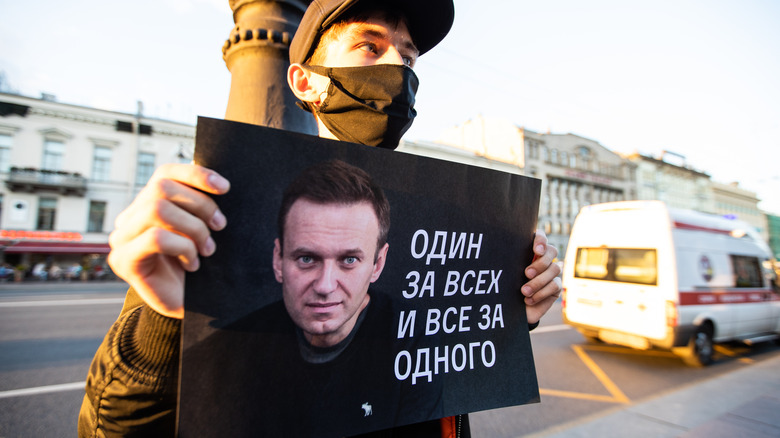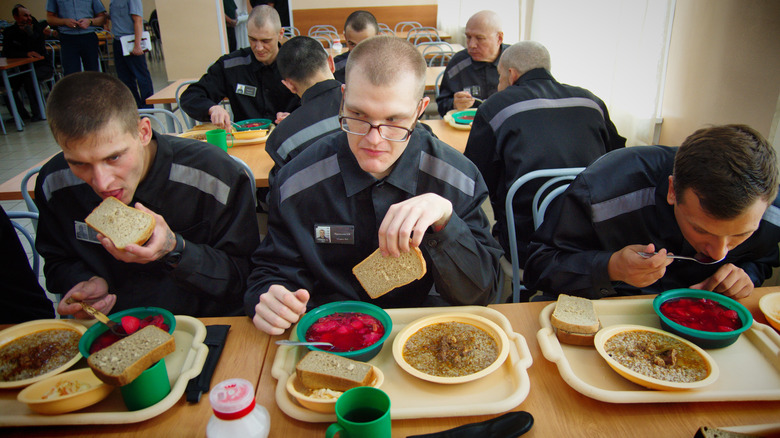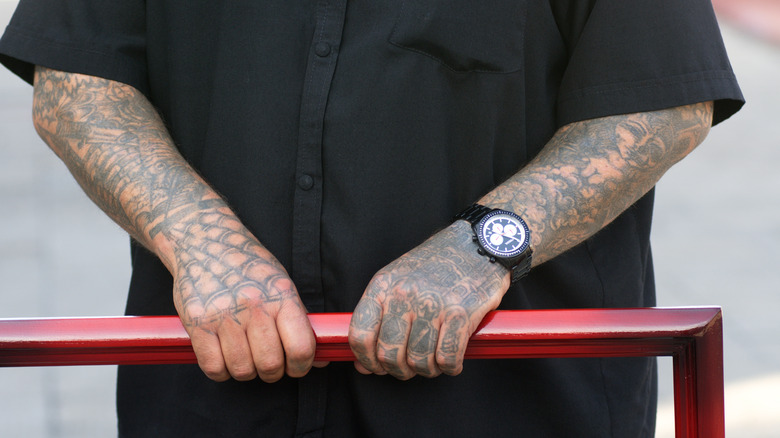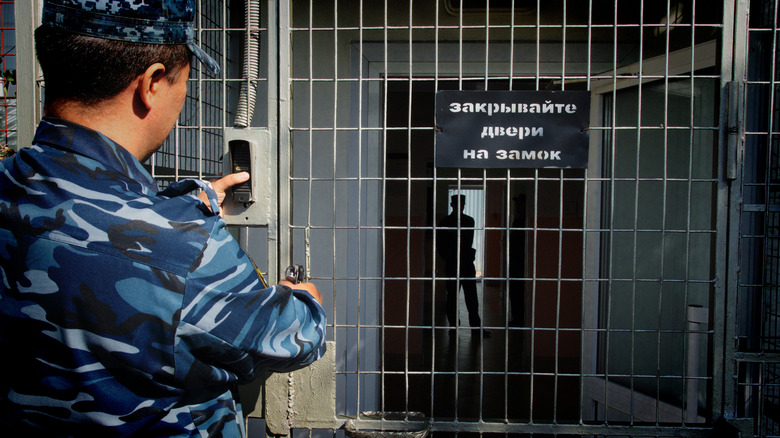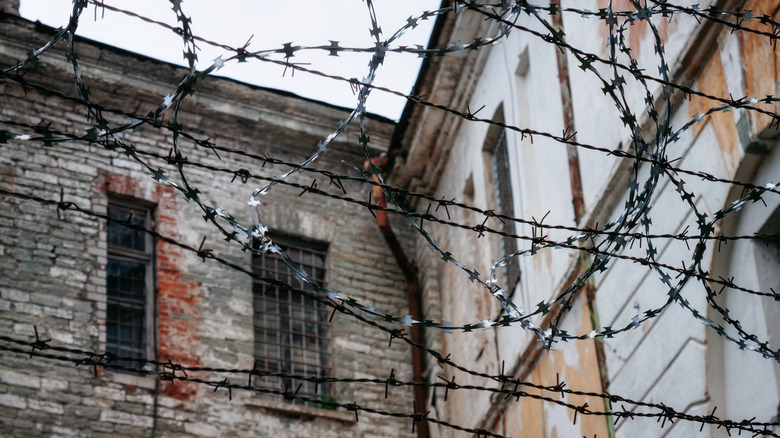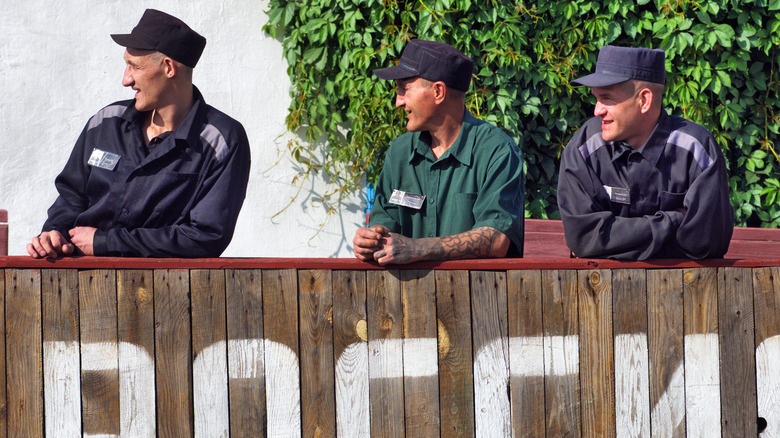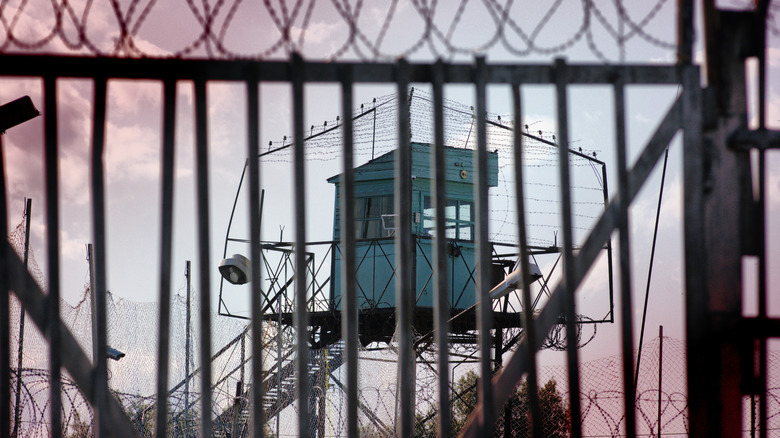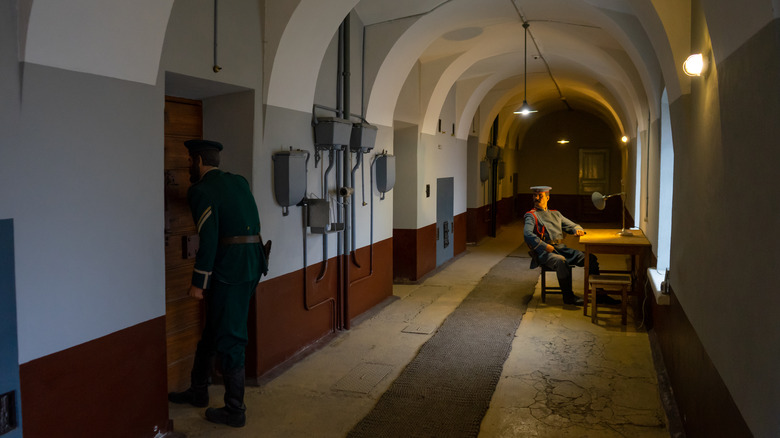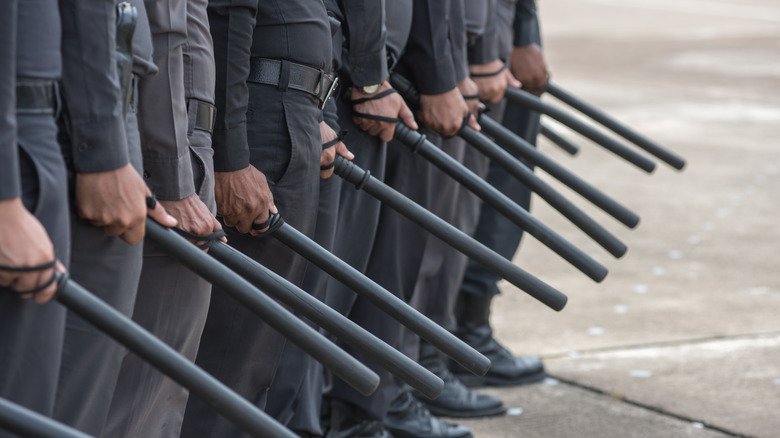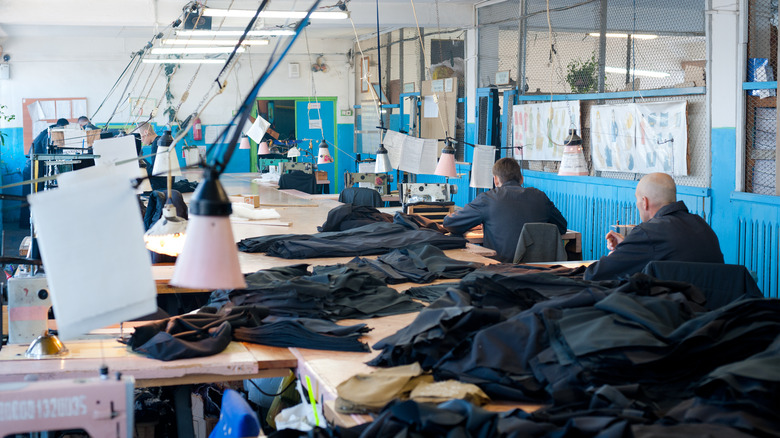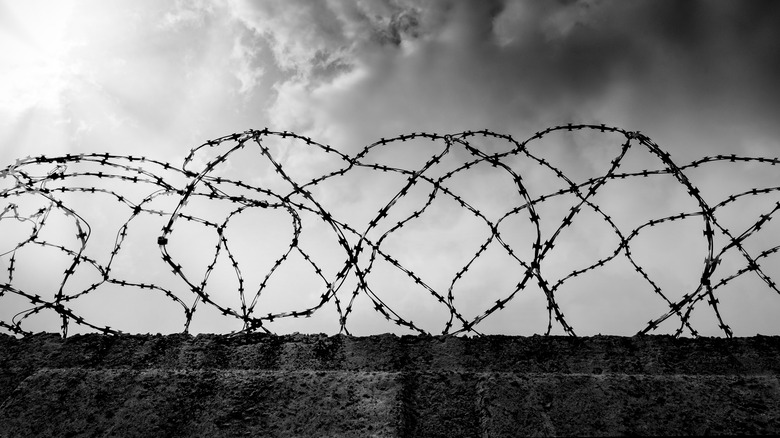What Life In A Russian Prison Is Really Like
Russia's brand of justice has made the headlines in recent months over two high-profile cases. The first involves American WNBA player Brittney Griner, detained until May 19, 2022, on narcotics charge, per VOA News. If convicted, she faces a five- to 10-year prison sentence. Griner tops the list of Americans detained in the country, including Paul Whelan and Trevor Reed.
As CNN reports, Whelan was arrested on espionage charges in 2018 and received a 16-year sentence in June 2020, denounced by United States officials as "unfair." Incarcerated in a rural labor camp, Whelan lives and works in "sweatshop" conditions, finding it "very difficult" to get medical care. Reed faced charges of endangering Russian police officers due to public drunkenness and is serving a nine-year prison term. Recent calls with his parents have revealed a chest condition, exacerbated by injuries, causing him to cough blood. The Reeds fear their son has tuberculosis, an epidemic in some Russian prisons, per the Newsline People AIDS Coalition.
The recent sentencing of Alexey Navalny, Russian opposition leader, to nine years in one of the nation's maximum-security prisons has also led to renewed scrutiny of the penal system, as reported by CNN. Here's the full scoop on Russia's prison system and what daily life may entail for individuals like Griner, Whelan, Reed, and Navalny.
There's no lack of fellow inmates
Russia has the largest prison population in Europe and ranks 17th worldwide, reports the Center for Eastern Studies. Today, there are roughly 321 inmates per 100,000 of the national population, according to Prison Studies. (For perspective, America's prison population peaked between 2006 and 2008 at 1,000 inmates per 100,000, according to the Pew Research Center). Of the nearly 464,183 prisoners housed in Russian facilities, foreign prisoners make up 6.2% of the population, and 8.3% of all prisoners are female.
Radio Free Europe reports Russian prisoners have faced dire circumstances related to overcrowding in the 21st century. So, if you happen to find yourself serving time in one of the penal colonies, hope you're a people person. At its worst in the early 2000s, inmate personal space amounted to little more than a coffin's worth. (No claustrophobia allowed.) Inmates had to take turns sitting and lying on bunks. Although the government has slashed the prison population by more than half since 2000, too many bodies remain crammed in tight spaces.
As recent political unrest attests, a couple of weekends of protesting can overwhelm penal colonies, per Euro News. Summer 2021 demonstrations for Alexey Navalny took place across the nation, resulting in thousands of arrests for "illegal demonstrations." By August, more than 800 protesters still sat behind bars. One video revealed 28 men in a cell made for eight. The room lacked cots, mattresses, and a flushing toilet. Instead, detainees used a squat toilet. (Basically, a hole in the floor.)
Longevity is greater behind bars
In December 2010, a series of U.S. embassy cables purported to detail conditions in the Russian prison system, per The Guardian. According to these cables, three physical features characterize the Russian penal system and the nation at large: extreme climate, vast distances, and a rigid bureaucracy.
The U.S. embassy cables point out the Russian system focuses on punishment rather than rehabilitation, which may lead to lower return rates. Statistics vary, with one source reporting the opposite, a high recidivism rate of 63%. (For comparison, America's revolving-door prison rate hovers at 70% in most states, according to The Crime Report.) Another surprising statistic deals with mortality rates for imprisoned men in Russia. They die at one-third the rate of men on the outside. U.S. embassy cables attribute this lower death rate to the dangers of life on the outside rather than the "healthy" state of prison conditions.
The New York Times reports that Russia has a very low life expectancy compared to other nations in the developed world. One statistic essentially says that American men have a better change of reaching their 55th birthday than Russian men. The primary culprit behind early death among Russian males is vodka, followed by car accidents. So, while there's no partying behind bars, the strict way of living might keep you alive longer, even if you're miserable.
Contagious diseases abound
Despite the fact Russian males live longer in prison, they do so surrounded by chronic illness. (The same goes for female prisoners.) Diseases abound, including AIDS and hepatitis (via The Moscow Times). While they likely won't kill you overnight, these conditions prove fatal over the long haul. They also lead to a general deterioration in the quality of life both before and after prison. But potential disease dangers don't end there. According to the Newsline People AIDS Coalition, more than 100,000 individuals in the prison system have tuberculosis, and thousands of these inmates have drug-resistant versions of the illness. In one two-year period, roughly 20,000 prisoners died from TB over 24 months.
Reuters paints an even grimmer picture, claiming that nearly half of all inmates in Russia's prison system are sick, with HIV as the biggest culprit. Statistics from 2010 claim that of the 846,000 prisoners in the system, approximately 55,000 had AIDS. Forty thousand prisoners suffered from tuberculosis, and 15,000 had syphilis. Finally, 67,500 inmates reported mental health issues. So, while your life expectancy might increase as a male in the Russian penal system, it would likely come accompanied by chronic illness.
Human rights advocates argue that the Russian prison system underreports the number of sick prisoners, per the Archive of European Integration. While gaining access to more accurate statistics proves challenging, Nikolai Krivolapov of Russia's Federal Penitentiary Service (FSIN) told journalists, "The big picture remains abysmal" (via Reuters).
Poor infrastructure means subhuman conditions
Russia's prisons aren't known for cutting-edge technology or posh amenities. Most date from before the 1970s, and many go all the way back to the Russian Empire, which ended with the Romanov family's execution on July 16, 1918, per History. So, it's been a minute since the original construction of these facilities. The result can lead to subhuman conditions for prisoners.
According to the Archive of European Integration, it's hard for inmates to maintain basic hygiene because the prisons are in disrepair, worsened by overcrowding. Lack of clean facilities exacerbates the likelihood of contracting deadly diseases. According to one former inmate of Colony No. 14 in Mordovia, Svetlana Bakhmina, she lived with 100 female inmates only permitted to shower once a week (via DW). Many resorted to covertly drawing water from prison radiators to wash during the week. If caught, they faced punishment.
Bakhmina also described a lack of adequate toilet facilities, claiming only one toilet served her barracks, and it didn't work. So, inmates resorted to using an outhouse. An op-ed by Olga Romanova reporting for The Moscow Times argues that this "obsolete infrastructure" has its origins in the gulag system. But corruption today has exacerbated the problem in new ways because of "the practice of nationalizing losses and privatizing profits." Despite the fact prisoners help pay for their stays, funds evaporate in the Russian penal system without clear improvements to correctional facilities.
Long-distance relationships reign
Convicts of the Russian prison system shouldn't expect regular visits from friends and family. Most penal colonies are located in remote areas "along the lines of Gulag camps created in the 1930s," per ABC News. Vast distances impede families and friends from regular visitation. For example, Zulaikhat Nurmagomedova has only seen her fiance once in two years because he's imprisoned 435 miles away in Mordovia, as reported by Radio Free Europe.
Even in cases where prisoners are closer to home, calls and visits get limited by prison officials, according to France 24. So, inmates must foster long-distance relationships from the penal colony, mainly through handwritten correspondence. According to Arkansas Online, some penal colonies now offer limited internet access through a third party. While inmates are not permitted to access the internet directly, they may give handwritten letters to guards. These guards scan the letters and attach them to emails, transmitting replies.
Although the system may sound a little backward, it represents a massive improvement over complete reliance on snail mail. According to Steven van de Steene, an IT specialist with the International Corrections and Prisons Association, "The last decade has been almost revolutionary in terms of allowing and delivering digital services to inmates." But not all convicts enjoy digital communication access, so letters remain the most effective way of staying in touch for many (via France 24).
One of four penal colonies decides your fate
As a Russian prison system inmate, your fate is intertwined with the penal colony where you get assigned (via Archive of European Integration). The system contains four types of facilities. The most lenient of these are known as colonies-settlements. In these facilities, house inmates reside in large barracks and can move about freely. They wear civilian clothing, enjoy leave passes, and even meet with family members, making these placements highly coveted among prisoners.
The next step up the security ladder is the ordinary regime penal colony, which has much stricter rules. If you're an inmate at one of these facilities, expect housing in large barracks typically with a 150-bed capacity. You can't move around the facility freely, and you face constant supervision. As for strict regime and special regime penal colonies, they house the nation's most dangerous criminals. Inmates stay locked in cells containing between 20 and 50 convicts.
The European Convention on Human Rights stipulates prisoners receive a minimum of 40-plus square feet of personal space, and Russian law states that inmates must receive at least half of that. But actual overcrowding puts convicts in much tighter quarters. And the higher the level of security, the more dangerous the other prisoners you're housed with. Apart from these differences, all Russian inmates in any one of these facilities face isolation and the potential for forced labor, per The Print.
Landing in an infamous penal colony is unbearable
San Quentin. Folsom. Rikers Island. Colorado's ADX. Some American prisons are so notorious, hearing their names can send a shiver down your spine, per WOLDC News. These facilities house some of the most dangerous prisoners globally and aren't locations where you want to do time. Some Russian prisons also have more brutal reputations than others.
For example, Penal Colony No. 2 is infamous for "unbearable" conditions, according to ABC News. This is the prison where opposition leader Alexey Navalny got sentenced to in 2021. Attorney Pyotr Kuryanov of the NGO Fund for the Defense of Prisoners' Rights has nothing good to say about Penal Colony No. 2. Located in the Russian village of Pokrov, Kuryanov refers to it ominously as "a breaking camp." Former inmates have gone on record arguing that Navalny likely won't face physical torture because of his high-profile status. But as one-time convict Vladimir Pereverzin elaborates, "They will psychologically break him."
Other prisons considered among the toughest in the nation include the Black Dolphin, located on the Kazakhstan border (via National Geographic). Expect to share space with cannibals, terrorists, and serial killers if you find yourself here. And don't assume you'll fare better as a woman, as reported by DW. Penal Colonies No. 13 and 14 in Mordovia house two women's prisons with fearsome reputations. Penal Colony 14 is so dreaded, women attempt suicide to avoid it (via Radio Free Europe).
Torture is a clear and present danger
In 2018, Russian media broke the story of Yevgeny Makarov, whose brutal torture at IK-1 in Yaroslavl, near Moscow, got caught on tape, per the BBC. Radio Free Europe reports the footage shows 17 guards holding Makarov spread eagle while taking turns beating the bottoms of his feet and his shins with plastic batons. Between pauses in the beatings, they pour water from a bucket over his head, and Makarov howls in anguish, begging for mercy.
The footage caused a public outcry, leading to the prosecution and sentencing of 13 guards seen in the video. But Dmitry Nikolaev, former boss of the prison, and Igit Mikhailov, his deputy, secured full acquittals. Sadly, Makarov's case is far from an isolated incident. In November 2018, a prisoner named Sultan Israilov got beaten to death by four guards, who initially tried to cover up the event as a suicide. Only after a prison-wide hunger strike did authorities step in to examine the case further.
Not only should you expect beatings at a Russian penal colony, but extortion is also a reality some prisoners face. Some families of prisoners at IK-7 have faced the extortion of millions of rubles by two officials to secure the safety of imprisoned family members. But perhaps the most heartbreaking story is that of Roman Sarychev. Guards beat him so severely at Penal Colony No. 6 in Yaroslavl, he died within three hours of arrival, as reported by the BBC.
Forced labor is a part of daily life
In addition to psychological and physical torture, Russian prisoners also face forced labor, evocative of Soviet-era gulags (via VOA News). The nation's correctional system decided to revive "compulsory labor as a criminal punishment" on January 1, 2017. Prison officials argue it's better than keeping inmates isolated from the world. What's more, Deputy Director of the Federal Penitentiary Service Valery Maximenko has cautioned against comparisons to the tactics of Stalin's USSR, arguing that prisoners who work receive perks like living in more desirable, lower-security facilities.
But according to Nadezhda Tolokonnikova of the Russian punk band Pussy Riot, working at a penal colony isn't all it's cracked up to be, per DW. In 2013, she penned a letter about her experiences at Penal Colony No. 14: "Everyday life in the colony is set up in such a way that prisoners who head a brigade and take orders from managers break a person's will, bully them, and turn them into silent slaves."
Fellow prisoner Svetlana Bakhmina backed up Tolokonnikova's claims, stating that work proceeded like an assembly line from dawn to dusk with compulsory overtime. Any woman who refused to work faced harsh consequences. Bakhmina also noted that production goals constantly increased, leaving prisoners exhausted and working to the bone. Zara Murtazalieva described sewing everything from gloves to army uniforms and tents while making little more than $20 per month. She also experienced beatings and the constant "incredible emotional pressure" of having surveillance cameras watching her every move.
Prison riots are a regular occurrence
On May 10, 2015, a riot broke out at IK-2, a strict regime prison in Salavat, per Novaya Gazeta. The riot involved approximately 100 inmates and led to the seizure of one of the colony buildings. Later, inmate/family forums stated the riot's cause as "dissatisfaction with the results of the amnesty for the 70th anniversary of the Victory."
Inmates of Russian penal colonies only have so much recourse when protesting forced labor, beatings, unhygienic living conditions, and lack of adequate medical care. There are hunger strikes, both by individuals and groups, and prisoners riot when things reach a boiling point. Unfortunately, riots don't improve prisoner conditions, as reported by France 24. Instead, they can lead to a vicious cycle of escalating abuse, including sexual violation and torture.
To avoid prosecution, prison officials often command fellow inmates to do the dirty work. This systemic punishment ensures there's always a fall-guy apart from higher-ups. One inmate who admitted to violating other inmates is Denis Golikov. In the wake of a deadly riot in April 2020, prison officials ordered him to get confessions from 150 fellow convicts. He later detailed in a handwritten statement, "Everything — except corpses — is permitted" (via France 24). Rioting and human rights violations on a massive scale aren't things you want to get used to, but they mark predictable parts of daily life in Russian penal colonies.
Your life is dictated by the Federal Penitentiary Service
As a Russian prisoner, every aspect of your existence is controlled by the Federal Penitentiary Service (FSIN) (via the Archive of European Integration). In other words, say good-bye to democratic concepts like the rule of law and fundamental human rights. Established in 1998, the FSIN employs approximately 325,000 workers and operates as a "state within a state" without consistent oversight.
Although prisoner populations have declined in recent years, FSIN employee numbers have remained relatively stable. As a result, there are 2.3 times as many penitentiary system employees to inmates compared to American prisons. To survive in this system, you must follow the rules made by correctional officers, even when they show blatant disregard for morality or legality. In the Russian penal colony, the FSIN alone is sovereign. According to one former prisons inspector, Akir Mirzoyey, "[Russian prisons] are crushing the prisoner as an individual and calling it the betterment of a person. That is the main aim" (via Reuters).
For his part, political prisoner Alexey Navalny hasn't witnessed any violence while detained, likening the accommodations to "a friendly concentration camp." But he has also noted hearing plenty of rumors about prisoners beaten within an inch of their lives using "wooden hammers." And he's seen firsthand "systematic medical neglect." These observations allude to the fact that for less high-profile inmates, prison guards may play judge, jury, and executioner with impunity.
It's a fight for survival
After Trevor Reed's imprisonment in 2019, the American and former Marine thought he'd never see his home again (via MSN). This fear grew into utter despair after 985 days in the Russian penal system. Reed was arrested after he allegedly got into an altercation with a Russian police officer while intoxicated, as per Newsweek. At his lowest point, he learned about the war in Ukraine, assuming it represented the final nail in his coffin. But then the unthinkable happened.
A prisoner exchange secured his release. The Biden administration negotiated the return of Konstantin Yaroshenko, conditional upon Reed's liberation. Yaroshenko, a pilot and convicted drug runner, had been sentenced to 20 years in prison in 2011 on charges of trafficking cocaine. Thanks to the international deal, Reed became a free man on April 27, 2022. Since returning to the United States, Reed has detailed the nightmarish experiences he faced in a series of Russian prisons. The constant theme running throughout his experiences was a visceral fight for survival.
During his nearly 1,000 days of incarceration, Reed faced isolation for 23 hours a day in a cell the size of a small broom closet. He worked in a forced labor camp he described as "out of medieval times" and spent time in a psych ward. According to ABC News, desperation led him to a hunger strike in November 2021, his only means of protesting the horrific conditions at the rural labor camp where he toiled endlessly. During this time, his health deteriorated greatly, which made the timing of his return critically important.
